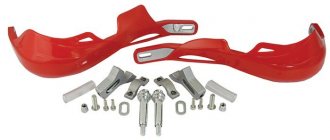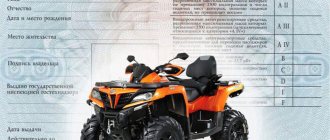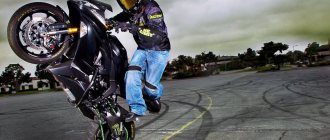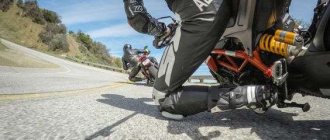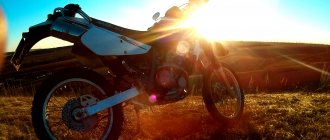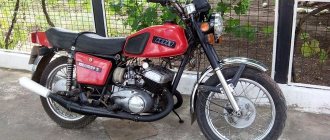An undoubted argument in favor of motorcycle life is the maximum sense of reality while traveling: no roll cage, no air conditioning, so if it’s hot, you feel it, and if it’s raining, you get wet to the skin. In fact, driving in bad weather is the same counterargument as a plus sign for the reality of sensations on a fine day.
What should you consider when driving in the rain?
- Bad visibility. You see poorly and they see you even worse
- Poor tire adhesion to the road surface
What do you need to know to avoid falling off your motorcycle in the rain?
If you ask a professional about how to ride a motorcycle in the rain, he will answer: “There is no way rainfall should keep a true rider from riding his favorite bike.”
A person from the UK has been chosen as an expert, who for 12 years, regardless of the weather, gets on his motorcycle almost every day - Chris Cope. As you know, the United Kingdom is famous for its abundance of rain, so the roads here are almost always wet. There's no better expert than Cope to consider how to ride a motorcycle in the rain.
5. Slow and extra braking distance
Slow down. If you're driving in the rain, you need to slow down. Allow extra stopping distance between you and others while driving. In wet weather, the distance to escape increases, so increase the buffer zone between your bike and other vehicles. Also, remember that you will need extra range to stop when approaching an intersection. Dry pavement is ideal for stopping, but wet roads significantly increase the distance you can travel.
So slow down So as not to take risks and offer yourself (as well as others) enough time to make decisions.
It all starts with the tires...
Tires are an accessory that many bike owners view as rotating pieces of rubber. But in reality, tires are more important for driving in different weather conditions. This is a combination of various chemical components with a specific tread pattern design, which is created by the manufacturer for certain operating conditions and technical characteristics of the bikes.
If there are no specific requirements for tires, such as providing high flotation or traction, the expert recommends buying tires that provide control and stability on wet roads. Chris himself prefers the Michelin Road series, but notes that Pirelli, Bridgestone, Metzeler and Avon have good models.
The riding style and class of motorcycles affects the type of tires, as well as the technical and operational requirements for them. For example, cruising and heavy touring models are not particularly demanding when it comes to tires. Often these are not very good samples. They are chosen by bikers who prefer trips in sunny weather and who pay more attention to the technical condition of the bike itself rather than their riding style. This trend is strong in the US, although cruiser flagships Harley and Indian have recently shifted to the European market.
But no matter what type of bike is chosen, a pro's rule of thumb is to choose the best wet weather tires the owner can afford. This rule is worth sticking to, even if you have to sacrifice durability or practicality when driving on dry asphalt.
Visibility
Precipitation, large or small, always spoils the view, flooding the pilot’s visor, the driver’s windshield, and the eyes of a frantic pedestrian hurrying across eight lanes of the highway home to watch the next episode of “Game of Thrones.” As a result, no one sees anyone, but suspects the existence of oncoming and passing traffic with rare surprises of citizens running out onto the roadway.
An Anti Rain coating on the visor will improve the situation in your favor, as will reducing your speed to a reasonable speed.
When riding in the rain, it is recommended to wear reflective vests or brightly colored raincoats because visibility is reduced and brightly colored gear will make you stand out from the crowd.
Probably the only motorcyclists who don’t mind any rain and generally sound like a challenge are endurists and cross-country riders, rushing to storm the track and puddles with happy exclamations of “Whee!” It is from these guys and girls that you should learn how to ride in bad weather or ask around about the behavior of a motorcycle when the grip on the surface is close to symbolic.
In urban environments, storming puddles is a bad plan. The road surface is treacherous not only because of the humidity, but also because of the holes hidden under water. If you were lucky enough not to fly your front wheel into an open hatch, this does not mean that such luck is endless. The greater the sediment, the faster the puddles turn into rivers, under which any road irregularities can be hidden.
Watch how cars drive through sections of the highway flooded with water, do they fall through a wheel, or go around some section? Try to increase the distance inside your lane to leave room to maneuver if necessary.
The right equipment
As soon as the issue with tires is resolved, a suitable model “for water” is selected, you need to pay attention to preparing the body. This means investing in some decent rain gear. Getting wet on a motorcycle means quickly freezing, which is dangerous for your health. When a person is cold, his physical and mental abilities decrease.
There are two types of rain gear: what a biker puts on when he thinks it might rain, and what actually keeps him out of the rain. Waterproof textiles and leather – what to choose? Experience has shown that the first material does not protect against moisture.
The Oxford Montreal 3.0 jacket and Montreal 2.0 trousers are gear that protects against rain. These are comfortable, everyday items you can rely on. They will really keep water out throughout the entire trip. In fact, a high-quality kit like the Aerostich Roadcrafter R-3 can withstand a downpour for quite a long time, but will eventually get wet if you travel in the rain all day.
For bad weather conditions, Old Certain School Rain Definite gear is your best bet. It's an ugly, plastic-like substance that goes over regular gear but provides waterproofing. It doesn't provide natural ventilation and doesn't look cool, but it effectively protects against moisture. After testing gear from Richie, Held, Weiss and Furigan, Chris decided on the Dens-Dust and D-Custa jacket. This is the equipment you need to be well prepared for any weather conditions.
prepare your motorcycle
Tires
Evaluate PSI and tread before riding. Make sure their pressure is correct for your motorcycle. A heavy downpour is not the time to try your luck with an airy or flat tire .
Your tires should be prepared for direct water, when water remains in the media, walking on the tires will dissipate it - very common, extra tread less water in the media and also more traction .
brakes
Your brake pads should have enough braking material to stop as needed in wet weather.
Gas level
Make sure you have plenty of gasoline in the storage tank before driving in the rain and make sure there are no leaks . Running out of gas during a tornado or rainstorm is not suitable. An oil leak can create a serious safety problem: when oil mixes with water, it becomes a recipe for unsafe and risky problems that can end your ride prematurely.
Headlights and reflectors
Make sure all headlights, taillights and flashers are working properly and that no bulbs go out. Make sure all reflectors are intact - they will definitely work during periods of poor visibility.
Tea and cakes are biker's friends
You should not consider bad weather as an obstacle that must be overcome at all costs. Competing with the weather is not always a good idea. In some cases, the best solution is to stop.
See also: How to properly drive a car in the rain
Unless you're traveling along the roads of the Pacific Northwest or the British Isles, it's best to head to the nearest café as soon as it starts to rain. This is due to the fact that oil residues and road dirt, when wet and mixed on the road surface, will turn it into a skating rink. Here it is better to order coffee, something else and let the rain 30 minutes or so to wash away all the dangers from the road. But short-term rain will not create a threat, so you should be guided by weather conditions.
Roads in Blighty are very rarely dry for days on end, so oil and mud are less likely to accumulate on them. The issue of seeking shelter is especially relevant if a long trip is planned. Even the best equipment does not provide 100% protection from rain. Here the most appropriate solution would be to stop for heating, drying things and rest - physical and moral.
anti-fog treatments
Fogging occurs when there is humidity and a difference in temperature levels on either side of objects. Consequently, rain, as well as airborne moisture, can cause your safety glasses, helmet visor, and windshield to fog during a rainstorm. When using a helmet, try to keep the visor open for air flow and to prevent it from fogging up. Never ever try to ride with a foggy helmet . It is best to use anti-fog agents. If you encounter a situation where fogging is imminent, stop until the problems are no longer a problem .
Avoid rainbow puddles
Rain does not wash away all the oil and dirt from the asphalt, so you need to carefully monitor the road. A biker must do his best to avoid the bright rainbow puddles that appear at roundabouts. But you shouldn’t swerve sharply and randomly to avoid them. If the oil patch remains unnoticed at a sufficient distance, there is no need to panic and slam on the brakes to make a controlled maneuver. The correct decision is to drive through such a puddle while maintaining control and balance.
Professionals often tackle rainbow sections of the road at high speed, creating a lot of splashes, but this is not always safe. The optimal solution is to drive through such “oil” spots at cruising speed while maintaining full control of the situation. The same applies to manhole covers, bridge expansion joints, railway tracks, road markings, pedestrian crossings and other dangerous places that become slippery when wet. They should be avoided in the rain and can be safely ridden in dry weather.
Turning in the rain
How to behave when turning in the rain? First of all, stick to the outside of the street. It is also important to reduce the speed so that you can easily reduce the incline angle. The motorcyclist must negotiate elements such as tram tracks at an angle close to a straight line. You can do this by standing on the pegs and shifting your weight so that the tires are perpendicular to the asphalt.
Avoid sudden changes in speed or direction. It may be that adhesion is insufficient. If one of your tires temporarily loses contact with the asphalt, don't panic. Never apply the brake thoughtlessly or let go of the throttle. If there is a chance that the bike will regain traction, it will do so on its own. Any rash behavior can only lead to a fall.
Gain a physical skill
The expert recommends taking an off-road motorcycle riding course, even if the biker prefers to ride on smooth asphalt. This will help you become more confident and remain calm in various driving situations.
One of the fundamental points in such courses is learning the correct movement of the body, shifting the center of gravity. Most often, the “right place” is closer to the ground. This can be as simple as moving your body closer to the tank or placing your weight on the pegs. However, you should not change the style radically, so that it does not negatively affect the comfort of travel.
In general, a rainstorm is not the best situation to try something new on the move. You just need to remember how and where to position your body - this will help when maneuvering. The most important thing is not to be too tense or relaxed. Nerves can make you tense, but you can't let them take over.
braking
Next to alertness is braking: the faster you see hazards and edges, the sooner and much more effectively you can use the brakes.
The key to stopping effectively in wet conditions is to do it effectively and gradually. This will definitely prevent your tires from going haywire, which is an integral part of safe driving in wet weather.
If you need to hit the brakes hard, pump them to stop hydroplaning. Do not simply apply the front brakes as this may cause the front wheel to blow out.
Apply more rear brake than usual . If your front wheel starts to slip, you have a problem. If you have a rear wheel, you can always fix it.
Attention, vigilance, caution
Every effort must be made to avoid erratic movements and sudden stops. The key to achieving this is keeping your attention on the road. The important thing here is to make every effort to anticipate problems and come up with ways to deal with them. In other words, bikers should ride as advised by RoSPA - the Royal Society for the Prevention of Accidents, one of several UK organizations that teach safe riding techniques.
Poor visibility typical of driving in the rain makes it difficult to scan the road, so you need to slow down. A biker should not ride faster than he can react. The advice has a double benefit: it will increase the chances of seeing an obstacle ahead, and also the motorcyclist will not be blinded by the moisture created by the wheels of cars ahead of the bike.
Hazardous factors
Every motorcyclist has certainly experienced wheel slip on a wet surface more than once. In such situations, some drivers feel insecure. However, it should be remembered that it is not only rain that causes a motorcycle to lose traction. Substances left behind by vehicles, such as engine oil, grease or washer fluid, are also important. Add to this the garbage thrown away by drivers.
These substances and debris do not disappear, but remain on the asphalt, crumbling into very small elements. When it rains, these factors make the road dangerously slippery. Of course, most of these impurities are washed off with water, but this requires a fairly large amount of precipitation.
Search for dry road sections
Motorcycles feel more confident on dry asphalt, so you should strive to move on it. After the rain stops, due to the intense traffic of cars, dry zones form in the area where the tires are adjacent to the road or in the middle of the lane. The last option is the result of the movement of air masses by trucks.
But it should be taken into account that trucks and long vehicles create a large amount of water dust, so you should not drive too close to them. You need to be especially careful when overtaking a large truck: the spray from the giant wheels is blinding.
keep calm
Maintain a calm stance with your back supported. The tightening of muscle tissue will cause tension in your mind and body and may also make you panic about the change in scenario. If you're tense and immobile on your bike, you'll struggle to ride efficiently and that's just one of the secrets to riding safely in the rain.
Try to keep your muscle tissues relaxed and maintain normal posture. Don't sit as straight and also relax - this way, any loss of grip will certainly not result in sudden movements of the entire body that will significantly affect your handlebars as well as the handling of the bike. As with suspension, if you're dangling, any unexpected slips, slides, and jerks are bound to be accounted for.
How to drive in the rain or how not to kiss the wet asphalt
Others. It's autumn outside. The temperature is dropping. The asphalt is cold, and the rain adds fuel to the fire
So here it is. For some, driving in the rain is a kind of romance, for others it is torture, for others it is the worst thing that can happen.
I scoured the Internet and brought here several articles that describe quite interestingly and instructively how to drive in the rain.
So, let's begin
Moving smoothly and carefully is task number one. You should not once again test the coefficient of adhesion of tires to the surface - it is clear that it is much worse, and often it is not particularly clear where exactly it will be especially slippery. Keep your distance so you can brake safely if necessary. On the other hand, you don't have to worry too much about the tires coming off - I can't remember many times when the tires began to slide uncontrollably when cornering in rainy weather, and I certainly never fell because the tires started to slide in a corner. Only once have I seen from the sidelines what hydroplaning is like on a bald front tire - when my friend and I were driving along I-5 near Seattle, Washington, but then he got into a fairly deep puddle. I want to say that there is a limit to everything, but in this case everything is not as terrible as you might think. (C)
The biggest mistake when driving on wet surfaces is sudden maneuvers and acceleration.
The physics of sudden acceleration happens like this - the initial speed gain is slow, because the wheel slips in the water, but when the wheel catches, it explodes and jerks forward.
The physics of a sharp maneuver is scary because inertia on wet asphalt increases and the motorcycle begins to carry further than the intended maneuver.
But what regularly fails motorcyclists is an incorrect assessment of the maximum possible braking force on a surface that only seems dry. One day while driving, I was approaching a traffic light and immediately in front of it I saw a clean and dry strip of asphalt, which gave me confidence. Having decided to test the performance of the front brakes, I squeezed the brake handle as hard as I could - and found myself lying on the asphalt faster than I could have imagined. Besides the battle-tested motorcycle, boots and leather jacket, my ego took a hit. Lesson? Dry asphalt does not mean you have dry tires. It’s also not for nothing that MSF (Motorcycle Safety Foundation) calls the middle part of the lane the “oil strip.” This is where the oil leaking from the engines of cars that stop at a red light ends up. (C)
Braking is the cause of most accidents and falls in wet weather. I myself managed to experience this when I traveled around Turkey on a motorcycle. On the very first day, I slowed down at a traffic light, the asphalt was slightly wet after the rain, and not twenty meters away I found myself on the ground, rolling next to a motorcycle and watching a truck approaching from behind. Everything went well - I managed to jump up and drag my bike out of the way. The cause of the fall turned out to be a white stripe of paint (in Turkey they paint something like a zebra crossing, but only across the road, at the approaches to traffic lights). It (the lane) was more slippery than the asphalt, so I made a pirouette on it, although to avoid this, I just had to release the brake and coast along it.
By the way, regarding the issue of oil streaks. My father, a motorcyclist and former designer of urban drainage systems and aqueducts, talked about the concept of “first flush.” The bottom line is that the dirtiest rainwater is that which falls on the roads and is washed off them by rain within the first couple of hours after the onset of bad weather. And the lesson for motorcyclists is that if you experience your first rain of the day (or for a longer period), know that the road is going to be especially slippery. This is a huge problem for places like Los Angeles, where drivers during the sunny and dry season completely forget about the lessons of last winter and continue to drive in the rain “like dry land”, and with the first autumn rain the mayor of the city is already calling the President with all his might, begging him declare the area a disaster zone. (C)
Oil stains, diesel puddles, sand, concrete... You won’t see anything on the roads of Russia. All this is dangerous even in dry weather: https://motocitizen.info/forum/topic/928-ljublinskaja-ulica-most-cherez-mkad-razlita-soljar/page-2#entry15382 And what happens to this at the beginning of the rain. It's impossible to describe.
Remember - closed turns (entrances onto overpasses - approx.). Heavy traffic (when you can’t see what’s under your wheels). Traffic jam (during rain). These are places where you can hug the asphalt if there is even a small puddle of diesel fuel on the way. How to avoid this?
Just like with marking stripes, you shouldn’t slow down/accelerate or, worse, stick your legs out. Go through a dangerous section by coasting or on steady gas and hold your bike firmly with your feet.
Well, you shouldn’t pretend to be Rossi when entering a turn, the surface of which you can’t see until the exit. I understand that a footplate that sparkles or a protective kneecap of a suit that rubs is cool, but much cooler is a route completed without falling, even if it took 10 minutes longer than usual. Know that it is better at 20:00 at home than at 19:30 in the morgue.
The main thing that most motorcyclists forget when riding in the rain is how important it is to stay dry and warm. After many trips in the pouring rain, and more than once getting soaked through, it dawned on me that often the simplest options are the best. The cheapest plastic rain suit you can find can provide an acceptable level of comfort (I use yellow industrial overalls and a plastic rain jacket). Complete nirvana can be achieved by wearing a fireman's jacket on top. The one I have is made of thick rubberized fabric, and when paired with a sweater, I feel completely protected from any weather. For additional protection from the wind, I had to sew a Velcro strip over the zipper. You have to wear a scarf because when you move the wind blows into the neck area, but nevertheless, when it comes to protection from moisture, this jacket is unsurpassed. (C)
All of you have probably experienced the feeling of being “completely dumb.” During it, your arms and legs involuntarily begin to shake, especially tense when working with motorcycle mechanisms in a traffic jam. And that woodenness that sets in after a hundred or two kilometers along the highway. In this state, you won’t even be able to dodge a hedgehog on the road. Do you know what happens if you put lousy gasoline into a motorcycle? What if I use old oil? Or don't change the air filter? It’s the same with you - you and the motorcycle are one mechanism, and the malfunction of any part of it leads to tragedy. Therefore, do not forget about yourself - warm, moisture-proof clothes will help you stay alive throughout the entire journey to your goal.
Now about the shoes. My personal experience is that rubberized boots and warm woolen socks are the way to go when traveling in the rain. These boots provide much more comfort than those thin condoms that are supposed to be worn over regular motorcycle boots. Well, except that they are even more unpleasant to walk in when you get off the motorcycle. The advantage of thin rain boots, which are usually included with raincoats, is that when good weather arrives, they can be put away in the trunk and will not take up much space. For this reason, it is indispensable when traveling. I can't say how good all these new super trendy "waterproof" motorcycle boots are just because I don't think they should cost $200 more than your average rubberized hiking boot. In my humble opinion, such simple boots for riding in rainy weather are quite enough, while they provide a sufficient level of safety, because in most cases, if you fall in the rain, you are unlikely to damage even your protective clothing. For example, in the above incident on I-5, my friend fell over at a speed of at least 60 mph and slid across the asphalt until he came to a complete stop, but the damage was limited to a slight tear in the thin plastic rain suit. Not a single trace was found on the leather jacket worn under the suit. (C)
A good motorcycle raincoat with shoe covers costs 2500-3500 rubles. But it can protect from any downpour better than a branded motorcycle suit from Dainoalpinikon. Don't skimp on what's important!
I haven’t been able to find the perfect gloves yet, but at the moment, the long, thick and very expensive gloves from Frank Thomas seem to me to be one of the best. They remain dry from the inside even when the outer layers of material can already be squeezed out. But in terms of heat retention, they leave much to be desired - at near-zero temperatures, your hands freeze a little in them. But keep in mind, this is on a motorcycle without fairings and heated handlebars. It is clear that if there were heated handles, a fairing and electric heating built into the gloves, the picture would be completely different. But it seems that they still haven’t come up with normal neck protection. The wind blows into the space between the helmet and the collar. You can partially protect yourself from it with the help of an ordinary thin scarf, but once it gets wet, you realize that it would be better not to have one at all. I think that a wide neoprene collar could be suitable here, but where can I get one? (C)
Hands are one of the important parts of the body involved in operating a motorcycle or scooter; high gloves with hand protection will save you not only from falling, but also from stiffening of your finger joints.
If there is no heating on the steering wheel grips, then this is not a problem - when stopping at a traffic light or in a dense traffic jam, place your gloved hands on the covers on the engine or hold on to the exhaust pipe. The thick layer of leather of the gloves will prevent you from getting burned, but this action will give a little warmth to frozen hands.
Please don’t do this if you have textile gloves, otherwise you risk leaving them on the engine parts of your motorcycle))
If you haven't gotten bored yet, here's an article from the bikepost:
To avoid getting wet or hypothermia: 1. long distances (in a raincoat): you can put rubber household gloves on your hands directly on top of your motorcycle gloves. for legs there are special shoe covers almost up to the knee. 2. short distances (in a raincoat): it’s not so scary to get your hands wet. but in order not to get hypothermic through them, it is better to dress a little warmer so that the body is warm. You won’t have time to get your feet wet in motorcycle boots. As an option, put your feet higher (passenger footrests or outriggers on a chopper) and drive less through puddles.
To make it visible (visor down): 1. pin lock on the visor so that the visor does not sweat from breathing. or treat it with an anti-fog agent (submariners have this for masks) 2. treat the outer side of the visor with “anti-rain”. the drops will not linger. As an option, try automotive nano technology 3. At speeds of 80 km/h, the drops fly off on their own. you just need to turn your head one way and the other. 4. At low speed, the glove can be wiped. 5. The worst thing is when drops fall on the inside of the visor (on the pinlock), if you lift the visor for some reason. Here you have to endure it or stop and wipe it. or are there other options?
How to drive: 1. test wheel grip on wet asphalt. To do this, on a free section of the road, actively slow down and see if the wheels skid (front + rear slow down using engine braking. And then it will wobble). see how hard you can brake. how motorists check ice. 2. don’t overestimate how slippery it gets! This is why the first point exists! Rain does not cause ice, but deteriorates traction. purely psychologically, usually the drivers themselves depress the situation and begin to panic ahead of time! Test the surface! 3. understand that motorists may have everything dripping and fogged up (windows, mirrors) and therefore their visibility is deteriorating. you are more likely to not be noticed. 4. if you don’t want to test and continue to worry more, then increase the distance not only for a longer braking distance, but also to provide yourself with calm conditions for assessing the situation and making a decision. to avoid any panic when braking! Due to the long distance, motorists will squeeze in front of you. it won't be pleasant. get over it 5. puddles and extremely slippery places (iron, convex markings) are passed on an upright motorcycle at steady gas. if you are in a turn, then the turn is made in two tilts: tilted, straightened before a slippery section, tilted again for the final passage of the turn. in a puddle it can start to wear off the front or shake the back. The main thing is not to panic, not to grab the steering wheel, not to let off the gas (sharp engine braking), not to add speed, not to slow down. the motorcycle itself plays everything. This is the simplest way to do no harm. Alternatively, turn off the gas gradually. It is useful to practice driving through puddles separately from roads. 6. Avoid ruts with water. cross from not at an acute angle (up to 10 degrees), but at a more direct one (from 30 is enough (I know that this is still considered sharp). It depends on the aggressiveness of the track and the speed). Hydroplaning is evil, but at the same time it is also good in the form of water skiing. And therefore you need to cross the track on a vertical and stable motorcycle! And speed can be an assistant in this matter! Again, the motorcycle can wobble, but thanks to its speed it will hold on itself! The main thing is not to clamp down!
As for the trajectory, see the figure.
Red color - danger (rails, track with water, curb), green color - life, black color - death at point No. 1 do not start a turn, but even take a right turn, a sharp turn and at point No. 2 the motorcycle must be vertical and go along straight (so it is more stable). We have passed the red hazard and then we need to make a sharp turn in the direction of point No. 3. Don't forget to practice!
Another article from the Internet:
Riding a motorcycle in the rain.
Adviсe. BRAKING
Analysis of accident data shows that in 85% of cases, motorcyclists brake incorrectly. In other words, they either fail to use the brakes at all, brake too hard (and lock up the wheels), or underuse or overuse the front or rear brakes. Thus, it appears that very few motorcyclists regularly practice emergency braking on dry surfaces, let alone wet ones.
Waiting for the next emergency to arise so you can practice emergency braking is not the best approach. The most common question that comes up is “How hard can I brake on wet roads?” The answer is simple: try it! The best way to improve your braking is practice. This doesn't mean you have to wait for it to rain when you're riding your motorcycle home from work during rush hour. Start improving your braking on dry roads, at a speed you feel comfortable with.
Take the HART (Honda Australia Rider Training) course to improve your riding skills. Once you have practiced and become more confident, gradually increase your speed and apply braking. Once you're comfortable braking in the dry, try braking in the wet, again starting at a speed you feel comfortable riding the bike at and then gradually increasing your speed as your basic skills improve.
CLUTCH
Many motorcyclists are concerned about tire grip on wet roads, especially when cornering. Naturally, the degree of grip decreases on a wet road as opposed to a dry surface. The solution in this situation is to limit your tire grip requirements. Drive the bike more gently, don't change anything too suddenly, i.e. Do not suddenly accelerate, brake or change direction.
In order to improve traction, the rider can change his position in the saddle. If the rider shifts their body position/weight to the inside of the turn, the bike will lean less into the road, so the tires will have more contact area and therefore more traction.
A prime example of how a motorcyclist can use saddle position to improve tire grip are Grand Prix riders (although they do shift their weight in extreme conditions).
On wet roads, tread depth becomes very important. The deeper the tread, the easier it is for tires to prevent water from accumulating, so worn tires will have less traction in the rain. There is a myth that lowering the tire pressure helps them warm up faster and increases the contact surface area with the road, but this is a misconception. The recommended level of pressure promotes traction as the tire maintains the correct shape and the tread remains loose and not pinched, allowing for better water shedding.
BRAKING DISTANCES
Who will stop faster in the rain - a motorist or a motorcyclist? As a rule, a motorist will stop faster. The car has the advantage of four wheels, so the total contact area of the tires will be higher. If a motorist locks the wheels in a panic situation, the car usually just starts to slide and skid. The motorcycle in such a situation tends to fall onto the road.
When you drive on a wet road, increase your distance from other vehicles. If you make a mistake and lock a wheel while braking, you will have more distance to release the brakes and brake again.
VISIBILITY
During rain, especially if it is heavy, visibility and visibility of the road ahead deteriorates. If your helmet glass is clean, water will drain off it more easily. When you check the situation on the road, turning around, water flows faster from the helmet glass. Having a clear view of the road ahead is one of the most difficult tasks a motorcyclist has to perform, especially in the rain. The further you view the road, the more time you have to react to changes in traffic conditions ahead.
APPROPRIATE MOTORCYCLE EQUIPMENT
If you get caught in the rain and get wet, you will soon start to feel cold. The colder you get, the more sensation you lose, especially in your fingers and toes. In order for the machine to work effectively, it is very important to feel the motorcycle when braking, it is also important to feel the clutch and gearbox. In addition, when you are cold, you lose overall concentration. Buy some decent motorcycle gear that protects you from the rain. The rain cover is quite compact when folded and fits into a rear case, bag or trunk under the saddle. If you carry a set of protective clothing with you when it rains, you will not only be more confident in riding your motorcycle, but the ride will be much more enjoyable.
DON'T STAY AT HOME!
Now that we have given some recommendations for driving in the rain, we need to put them into practice. Don't stay at home because of a bad weather forecast. With the appropriate motorcycle equipment, a working motorcycle and a good mood, riding a bike is always interesting, regardless of whether the sun is shining or raining. Get out of the house and ride for fun! (Honda Australia Rider Training).
SLIPPERY ROAD SURFACE DURING RAIN
1. Some motorcyclists believe that as soon as the rains begin, they should hide the bike in the garage and wait until next spring, when the sun begins to shine again. Such people deprive themselves of a lot. You can have a lot of fun riding in the rain if you know what to expect and know what to change in your two-wheel riding style.
First of all, you need to dress appropriately. A good rain jacket, gloves, boots and maybe even a heated vest will help withstand even the heaviest downpour. But the most important thing is that you need to change your motorcycle control technique.
The speed must be adjusted gently and changed little by little; the motorcycle should be tilted less towards the ground; Braking should be done gradually, and braking should begin earlier than usual.
2. When driving on wet roads, pay special attention to intersections. We all know very well that after rain an oil film appears on the road surface, but what happens in those places where there was oil on a dry surface? The highest concentration of oil appears on those sections of the road where cars stop, therefore these are very slippery areas. Rain makes the situation even worse. When riding a motorcycle you may not notice such a place, so it is best to slow down when approaching intersections.
Don't try to cross an intersection when the light is yellow, because if you have to brake quickly, you're more likely to lose traction.
When you stop at a red light, look in your mirrors and be aware that a motorist might brake too late and hit you in the rear. Also, double your normal (on dry road) braking distance to avoid accidentally driving into someone's rear bumper.
3. Two things can be noted that radically change the grip of tires on the road during or after rain - manhole covers and patches on the road surface. When it rains, such places turn into slippery black ice. When you're driving in a straight line they're less of a threat, but if you're turning, pay close attention to the lane you're traveling on. Release the brakes early and choose a path where there are no areas that limit tire grip. Usually the patches are blacker than the rest of the road surface. Such patches can be found both in the city and on rural roads, and they can be short and small, for example, when a crack is filled, or they can be healthy. If you notice such a patch, try to avoid sudden acceleration or braking. If you need to change lanes or turn into a dirt lane, don't strain your hands on the handlebars, relax them, and lean the motorcycle only as far as is absolutely necessary.
4. Although the following recommendation seems quite obvious, it is surprising how often you see motorcyclists riding in a wet lane while the other lane is already dry. Dry roads provide excellent traction and allow for safe maneuvering, so always try to choose dry areas of the lane. If you can force yourself to slow down and relax, you'll find that riding in the rain (or even traveling) is not only fun, but also rewarding - you'll improve your skills, gain more experience, and gain confidence.
Driving in the rain on city streets, of course, can be quite nerve-wracking, but this does not mean that when the sky is clouded, you should sit at home and cannot ride. If you remember the basic rules, driving in the rain can be easier and safer than it might seem. And besides, who wants their motorcycle to sit in the garage five months out of the year?
Author: Will Jacobs Translation: IMC, St. Petersburg, Ltd. Photos: Dean Groover
In addition to this material, we decided to reprint our article, which was first published in 2002.
MOTORCYCLE AND GRIP IN RAIN
The biggest problem when riding in the rain is that the driver has absolutely no idea what the motorcycle tires are capable of and how hard they can brake. As a result, the driver often drives with unnecessary precautions. Many people unreasonably slow down on a clear, empty road with good coverage and visibility, when it is quite safe to drive at a decent speed even in the rain. Perhaps not as fast as on dry surfaces, but still fast enough. In traffic, you will probably have to go with the general speed of traffic, otherwise you will annoy other drivers. There is nothing wrong with driving your motorcycle carefully in the rain, but being too careful will begin to affect the negative attitude of other road users towards you. If you know what you can and cannot do, then driving in the rain can even be enjoyable and interesting!
Coating grip
Think about how rain affects traction. Approach this logically - look at the surface of the road and ask yourself how long has it been raining? Of course, a wet surface has less grip than a dry road, and you will have to reduce the angle of the motorcycle and increase the braking distance. However, if the road surface is clean and smooth, a bike with modern tires will have a fairly high degree of grip.
Problems begin when the road surface is dirty and/or uneven. You cannot level the road surface. You have to accept her for who she is.
Monitor the condition of the road ahead of you. Notice changes in the surface in advance and try to choose a trajectory so that the motorcycle passes on a better surface. Watch for changes in the color of patches on the road - these could be patches made from particularly slippery materials, holes, pockets and cuts in the surface, or “polished” sections of the road.
You've probably noticed that your motorcycle slides more on some surfaces than others. Some surfaces that are perfectly safe to ride on in dry weather become almost unsuitable for two-wheeled vehicles in the rain, other surfaces have the grip of a track, some surfaces have average grip, regardless of whether they are dry or wet. It is useful to know how these surfaces differ. It is better to learn this in theory than to test it the hard way.
Don't forget about surfaces that become very slippery in the rain: - Metal manhole covers - Reflectors and reflectors - White lines and other road markings
- "Polished" and worn areas of the road - Tarred/tarmac joints - Fallen leaves - Oil stains.
In wet weather, all these types of surfaces shine! As a general rule, consider any shiny spot or area of the road to be potentially slippery and, if possible, try to avoid driving on such surfaces.
Avoid areas where oil, grease and dirt most often accumulate: - Between the wheels of vehicles at traffic lights and stop signs - On the outside turn line (in other words, on the right side of the lane when turning left and on the left side of the lane when turning right) - On U-turns
The biggest danger is spilled diesel fuel. According to FEMA statistics, 10% of all motorcycle accidents are caused by diesel. In this case, your nose, “flair,” can help you. Typically, you can smell the diesel before you drive over the spot. In addition, beware of driving over shiny but dark spots, smudges, as well as along those sections of the road where a rainbow effect is formed (rainbow iridescent spots).
In principle, road surfaces become especially slippery after short periods of rain in the summer months, immediately following a dry road condition - the oil that falls on the road mixes with the remnants of worn rubber, which creates extremely slippery spots and areas. Long rain washes oil and rubber off the road, and when the surface is in normal condition, the road has fairly good grip.
Avoid excessive accumulation of water on the road: puddles, streams, streams, etc. Don't forget that assessing the depth of a puddle is often difficult, if not impossible. There may be streams running along the road that carry dirt and gravel onto the surface, which can accumulate below the surface of the water and you won't see it. Don't be surprised that sections of the road at the base of the hills will be extremely slippery after a heavy downpour. Deep pockets and potholes can cause you to lose control of your motorcycle if you hit one at high speed. Sometimes an idea of the depth of a puddle can be given by comparing the surface with the height of a curb or road fence. In general, try not to drive through puddles; you may either end up in a deep pothole or run over something that is hidden under the surface of the water.
A compromise must be made. In order to find areas with good grip, you need to look for them. More importantly, do not choose a trajectory that deprives you of choice and does not give you the opportunity to maneuver. When you don't choose extreme trajectories, you have the opportunity to change the direction of movement. If you keep your distance from tarmac seams and white lines, you can turn with plenty of grip without worrying about slippery surfaces and falling. You need to look ahead and think about what you are doing.
The key when riding in the rain is to perform your actions and maneuvers evenly and smoothly. Try not to suddenly change direction or speed. It's very simple - try to ride softly and consistently. The less/less often you use the control knobs, the better.
Don't forget that a motorcycle's braking distance will double or more on wet surfaces, so start braking with that fact in mind. When you start to brake, do it softly and progressively - you'll be surprised how much more grip you'll gain if you give the suspension a chance to settle into a stable state. If you apply the front brake suddenly, lock it - on wet surfaces it will work before you have time to react. As on dry roads, and especially on wet roads, it is best to enter a turn with the brakes released, transferring your weight to the rear of the motorcycle and carefully using the throttle.
When accelerating, do it gently and take into account that you will need to shift earlier than usual. This will reduce the likelihood of the rear wheel skidding when speed increases or at high engine speeds. However, you should not make the mistake of running at too low engine speeds. Most engines don't feel very good in the low end and will need higher revs to maintain revs. Keep the engine operating in the most acceptable, optimal range for it, but shift towards lowering the speed, rather than increasing its number.
When making turns, the same technique is used as for dry surfaces, but in the rain the need to do everything correctly increases enormously. Finish braking while the motorcycle is moving in a straight line, give the suspension time to calm down, stop oscillations, enter the turn softly, maintain low power in the turn (for this, accordingly, you need to choose a trajectory, a line that allows you to maintain a soft acceleration, which, in turn means you must select a later apex (apex) of the turn), which transfers the load to the rear wheel and helps the front wheel make the turn.
When the motorcycle is tilted, accelerate especially gently, use the throttle carefully, and apply higher acceleration only when the motorcycle has reached a vertical position. A skid on a straight line is usually easy to control; a skid on a wet surface when the motorcycle is tilted towards the surface will almost inevitably cause the car to fall.
In most cases, you can lower the motorcycle further into the surface than you think is safe, but you should avoid sudden, sudden movements. When the surface is dry, you can start turning later, turn the steering wheel faster and reduce the turning radius. This technique can also be used in the rain. This technique is safe, since it opens the turn better, but you need to enter the turn at a lower speed, perform the maneuver more softly and make the turning radius softer (larger).
This doesn't mean that you should turn into a corner too early - many riders turn too early, even in dry conditions, losing their line mid-turn, which forces them to brake into the turn, trying to slow down. In wet weather, such actions are even more fraught with consequences.
If you have to brake in a corner, use the rear brake gently, not harshly, and be very conscious of the front end. You can have a very high degree of traction, but if you stall on the brakes, you are more likely to fall. If your rear brake is locked, there is a way to avoid falling: engage the clutch to disengage the drive. The motorcycle will swerve, but if you do everything quickly enough, the motorcycle will not fall.
Author: Kevin Williams Translation: IMC, St. Petersburg, Ltd. May 2002

